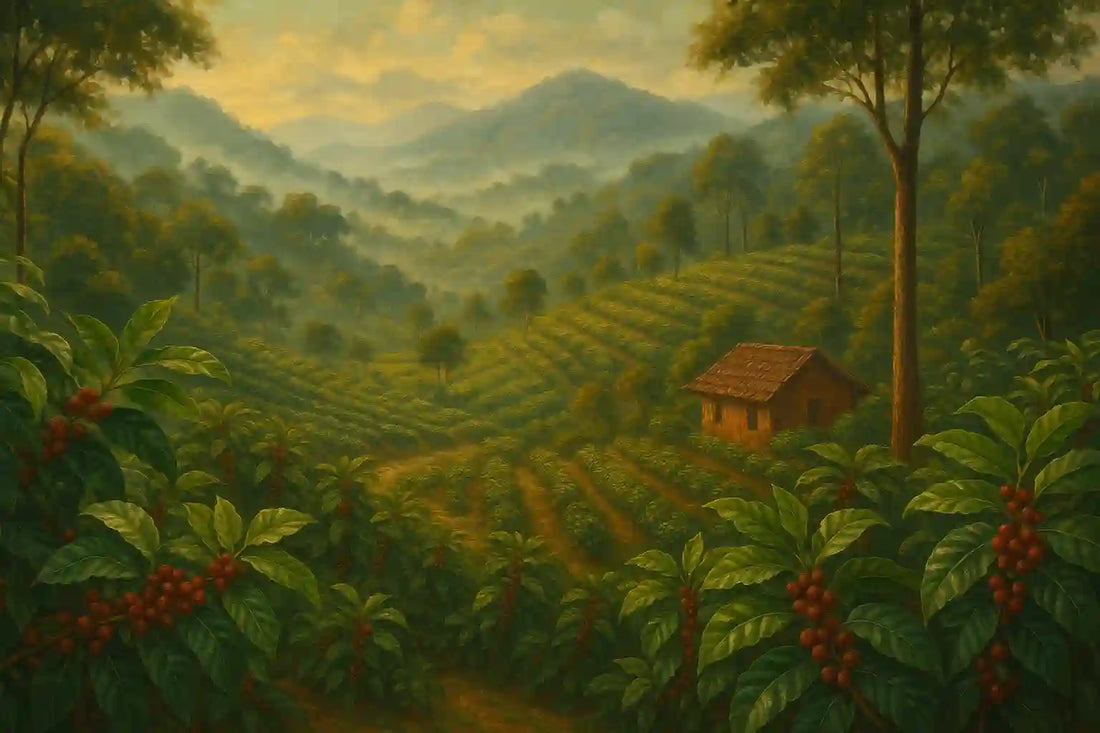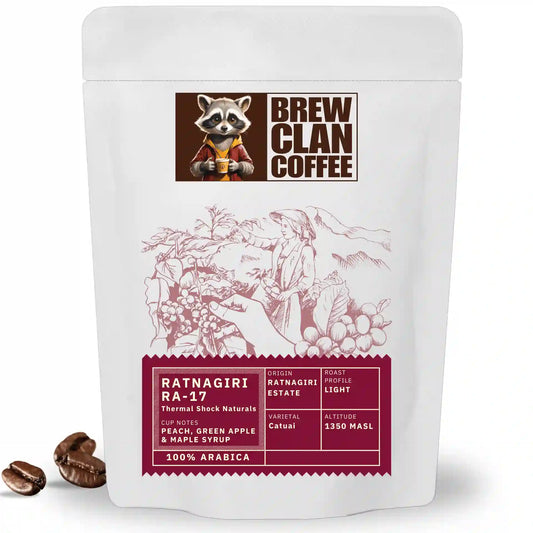
The Hidden Gems of Indian Coffee Estates: Where Your Morning Brew Begins
Share
Where It All Begins | In the Hills of India
Before your coffee ever kissed your lips, it woke up to misty mornings in Coorg, ripened under monsoon skies in Chikmagalur, and soaked in red earth alive with cardamom and pepper vines.
Most people think of Brazil or Colombia when they think of great coffee. But quietly, in the lush folds of India’s Western and Eastern Ghats, some of the world’s most character-rich coffees have been growing for centuries, nurtured by families who treat coffee as both science and soul.
This story is for every curious coffee lover who’s ever wondered where their morning brew truly begins. By the end, you’ll not only know where India’s best coffee comes from, you might just find a new estate to fall in love with.
Key Takeaways
India’s Coffee Legacy: It began with seven beans smuggled from Yemen by Baba Budan in the 1600s.
Geography Defines Flavor: Altitude, rainfall, and soil shape how each coffee tastes.
Chikmagalur Leads Specialty Coffee: Home to India’s most famous estates: Ratnagiri, Baarbara, Balanoor.
Estate Coffee = Authenticity: Each origin tells a unique story of soil, people, and craft.
Modern India Is Innovating: From natural and honey processes to traceable micro-lots, India is redefining global coffee expectations.
How Coffee Took Root in India

The Legend of Seven Seeds
Every great story has a beginning, and Indian coffee’s begins with a daring monk named Baba Budan.
In the 17th century, during his pilgrimage to Yemen, he secretly tucked away seven coffee beans and brought them back to India around 1670 CE. Those beans found a new home on the misty slopes of Chikmagalur in Karnataka, and with them, a new culture was born.
The British Era
By the 19th century, coffee had become a colonial obsession. The British set up sprawling plantations across Coorg, Wayanad, Nilgiris, and Shevaroys, turning coffee cultivation into a thriving industry. The legacy of those early estates still stands, though the hands tending them have changed.
Modern India’s Coffee Renaissance
Fast forward to today, Indian coffee is undergoing a quiet revolution. A new generation of growers is moving from commodity-grade exports to specialty-grade excellence.
Names like Ratnagiri Estate, Baarbara Estate, and Balanoor Estate have become synonymous with innovation, traceability, and flavor craftsmanship.
The Geography of Indian Coffee: Why It Matters
Every estate has a signature, and it’s written by its geography.

Altitude and Microclimate
Coffee loves altitude. The higher it grows, the slower it ripens, building complex sugars and bright acidity.
- Low-altitude coffees (below 1,000 MASL): fuller body, milder acidity, nutty flavors.
- High-altitude coffees (1,200–2,000 MASL): brighter, fruitier, and often floral.
Soil and Rainfall
India’s Western Ghats, a UNESCO World Heritage site, gift coffee with rich lateritic soil, heavy monsoon rainfall, and shaded canopies that mimic natural forests. These conditions slow the growth of coffee cherries, allowing deeper, more layered flavors to develop.
Biodiversity: Nature’s Secret Ingredient
Unlike monoculture farms, Indian coffee often grows under the shade of jackfruit, rosewood, and silver oak trees, alongside black pepper and cardamom. This intercropping not only supports biodiversity but subtly influences the cup, a whisper of spice, a hint of forest sweetness.
Meet India’s Coffee Heartlands
Let’s take a journey across the country’s most iconic coffee-growing regions, each with its own soul and flavor fingerprint.

Chikmagalur, Karnataka - The Birthplace of Indian Coffee
- Altitude: 1,000–1,500 MASL
- Flavor Personality: Balanced, chocolatey, gentle acidity
- Famous Estates: Ratnagiri Estate, Baarbara Estate, Balanoor Estate
Chikmagalur is where it all began, and where India’s specialty coffee movement still beats strongest. Its undulating hills and consistent rainfall make it a dreamland for Arabica cultivation.
Expect cups that are smooth, rounded, and full of life, from dark chocolate and hazelnut to citrus and tropical fruit. It’s also home to India’s most experimental estates - ones that are redefining how the world perceives Indian coffee.
Coorg - The Land of Bold, Aromatic Brews
- Altitude: 900–1,100 MASL
- Flavor: Full-bodied, nutty, spiced undertones
- Best For: Espresso and milk-based brews
Coorg is where the forest meets the cup. Coffee here grows under dense shade, sharing space with pepper vines and fruit trees. That natural symbiosis creates rich, earthy cups that taste like roasted nuts, cocoa, and warm spice.
Newer estates are now experimenting with honey and natural processing, producing small batches of complex, modern Indian coffees.
Baba Budangiri - The Legend’s Hills
- Altitude: 1,200–1,800 MASL
- Cup Profile: Fruity acidity, herbal undertones, medium body
Named after the saint who started it all, this range of hills remains a spiritual and agricultural landmark. Smallholder farmers here produce micro-lots: tiny, traceable batches that end up in the hands of India’s top roasters.
Expect lively, wine-like profiles with hints of herbs and red fruits, a taste that’s as timeless as the legend himself.
Nilgiris, Tamil Nadu - The Southern Elegance
- Altitude: 1,000–2,000 MASL
- Cup Notes: Floral, tea-like, citrusy
- Ideal For: Pour-over and filter brewing
Nilgiris coffees are like poetry in a cup - delicate, aromatic, and quietly complex. The region’s cool, misty air and fertile soil shape coffees that resemble fine teas, often carrying jasmine, bergamot, or stone-fruit notes.
If you prefer clean, light-bodied coffees that linger softly, Nilgiris is your perfect match.
Araku Valley, Andhra Pradesh - India’s Hidden Specialty Haven
- Altitude: 900–1,400 MASL
- Flavor: Bright acidity, red fruit, honey-like sweetness
- Produced By: Tribal farmers using organic methods
Araku Valley might be India’s youngest coffee region, but it’s also its most inspiring. Tribal cooperatives here practice organic, regenerative farming, and their coffees have won global awards for sustainability and taste.
Expect flavors of red berries, citrus, and a clean, honeyed finish - proof that specialty coffee can thrive outside the traditional belt.
The New Wave: Estates Leading India’s Specialty Coffee Movement
India’s coffee story is no longer about mass production — it’s about character, traceability, and craftsmanship.
Three estates in particular are shaping this movement:
Ratnagiri Estate
Run by Ashok Patre, Ratnagiri has become a synonym for innovation. From anaerobic naturals to honey-processed micro-lots, their coffees burst with layers of raspberry, peach, and maple syrup-like sweetness.
Baarbara Estate
A family-run legacy since 1896, Baarbara crafts balanced, classic cups — smooth chocolate, mild citrus, nutty finishes. A favorite among baristas for its reliability and clean taste.
Balanoor Estate
A champion of sustainability, Balanoor grows traceable, shade-grown Arabica that offers caramel, spice, and rounded sweetness - a perfect bridge between tradition and modernity.
How Altitude and Processing Shape What You Taste
Every sip of coffee carries two invisible variables: where it was grown and how it was processed.

Altitude
- Higher altitudes (1,200+ MASL): fruity, bright, floral notes.
- Mid-altitude (900–1,200 MASL): balanced, nutty, sweet.
- Lower altitudes (below 900 MASL): rich, bold, chocolaty.
Processing Method
- Washed: Clean, crisp, mild sweetness - perfect for clarity lovers.
- Honey: Balanced sweetness and body - like golden syrup in a cup.
- Natural: Bold, fruit-forward, syrupy - ideal for adventurous palates.
Each estate experiments with these processes to bring out a distinct signature, one that you can taste, recognize, and even chase across brews.
Why You Should Try Single-Estate Indian Coffee
Buying single-estate coffee isn’t just about caffeine, it’s about connection.
- Traceability: You know exactly where your beans came from — the soil, the farmer, the altitude.
- Character: Each estate tells a different story through flavor.
- Sustainability: Shade-grown, wildlife-friendly farms preserve ecosystems.
- Experience: You get to taste terroir — India’s landscapes, in liquid form.
So the next time you reach for a bag, look for the name of the estate. It’s not just branding - it’s a promise of authenticity.
Bringing the Estate Experience Home
Next time you sip your morning cup, imagine the slopes it came from rain-drenched hills, red earth, and the hum of cicadas between rows of coffee trees.
Because every great coffee starts with an estate, and ends with someone who truly appreciates it.
And if you’d like to experience this journey yourself, start by exploring single-estate coffees from Ratnagiri, Baarbara, or Balanoor — each one a story brewed to perfection.
FAQs About Indian Coffee Estates
Q1: What are the main coffee estates in India?
Some of the most renowned estates include Ratnagiri, Baarbara, Balanoor, Badra, Kalledevarapura, and Harley Estate, primarily in Chikmagalur and Coorg.
Q2: Which is the best region for Indian coffee?
Chikmagalur is considered the heart of Indian coffee — home to high-altitude farms, rich soil, and innovative producers leading the specialty movement.
Q3: What makes Ratnagiri Estate coffee unique?
Ratnagiri is known for its experimental processing — from honey to anaerobic fermentation — producing incredibly fruit-forward, sweet, and complex coffees.
Q4: Is Indian coffee Arabica or Robusta?
India grows both, but the specialty segment is dominated by Arabica, prized for its nuanced acidity and aromatic complexity.
Q5: Are Indian coffee estates open for tours?
Yes! Many estates in Coorg and Chikmagalur offer plantation stays and guided tours — a great way to experience coffee from seed to cup.




